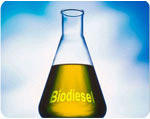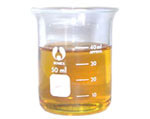

Overview
A. "Waste –To – Fuel" Technology For Producing Nano-Bio-Diesel (NBD) - Revolutionary Technology Breakthrough From USA
This is a new technology for turning everyday Municipal Garbage and landfill wastes, organic, animal and agro wastes into diesel fuel.
"We really can convert regular household waste, medical waste, anything that is not radioactive, metal, glass or porcelain, into diesel fuel."
Our Principals, a US-Tech Company has developed, which they call "Nano Bio Diesel". This process inexpensively converts biomass and municipal waste into high quality diesel fuel, which could solve the world's energy and waste problems at the same time, without upsetting the CO2 balance.
The conversion of input waste to fuel output is around 25-30% efficient. One ton of input waste will produce around 120 gallons (~3.8 barrels) of diesel. Materials that can be converted to diesel fuel through this process include plastics (including PVCs), rubber, waste oils, agricultural wastes (food and animal waste) and wood.
The product is not biodiesel, but is a pure hydrocarbon diesel, equivalent to what comes out of the oil fields.
B. Technology Giver Company: From USA. Unique Process Patented by Tecnocrats.
The future way of economical production of high quality synthetic Diesel fuel:
Expert Authentication :
New Energy Congress members and renowned Scientists & Technologists were invited to a 2-day walkthrough under NDA to see the working Pilot Plant, hosted by the owner and plant manager of of the NBD Plant. Other attendees were from various countries from around the world interested in finding solutions to their municipal waste issues. "We sampled fresh products from the petroleum cracker and saw how the proprietary catalyst was used to help process waste materials into petroleum. We were delighted with the results."
How the Technology Works
The CDP Plant is a self-sustaining energy production platform. It only uses up to 10% of its own energy production to run the plant through a 230kW block-type total energy plant (BHKW).
In the plant's closed-process cycle, the input waste materials reaction characterized by the following results:
Since the approved input waste materials are mixed completely into the reaction oil at a temperature of over 300°C and no further separation possibility exists once in the process, no protein molecules (thus no Prions) are present without exiting and reduction to decomposition or into the product, in this case Diesel fuel.
Advantages
Residue Qualities
Even new technologies, such as the hydrogen gas cell concept that produces CO/CO2 as a byproduct during hydrogen production, cannot exhibit such positive energy balances as our process, and do so with nearly complete removal of residual substances.
The lead-time for installing one such a plant is six months. The plant will be built at a manufacturing facility in the US, then shipped and assembled at the destination site. GPI will finance half of the project capital and will receive half of the revenues generated.
 In March of 2008, our Principals have completed their first full scale plant that is capable of processing 100 tons of municipal and other waste per day in a low heat and low pressure, proprietary catalytic system, converting the feedstock into high grade fossil free fuel TM, including diesel, kerosene, and fuel oil; as well as electricity and an asphalt component, produce fuel and electricity. The key to the system is the catalyst (trade secret), which is made from environmentally benign components.
In March of 2008, our Principals have completed their first full scale plant that is capable of processing 100 tons of municipal and other waste per day in a low heat and low pressure, proprietary catalytic system, converting the feedstock into high grade fossil free fuel TM, including diesel, kerosene, and fuel oil; as well as electricity and an asphalt component, produce fuel and electricity. The key to the system is the catalyst (trade secret), which is made from environmentally benign components.
A 100 ton/day facility will employ approximately85,000 man hours per year, in three shifts per day, and will produce around 120 gallons of usable fuel per ton of feedstock processed. Methane generated in the process is used to run a generator to power the facility, with 1 Megawatt excess available for feeding on to the Grid for public distribution.
The preparation of incoming waste stream includes chopping, extraction of metals, glass, and sand, so that approximately2/3 of the feedstock can be run through the unit to Municipal Solid Waste (MSW) consists of 80-90% of polymerized long chain hydrocarbon molecules. By the de-polymerization, or "cracking" process, the long molecules can be reduced to shorter length molecules with approx. 10-20 Carbon (C) atoms – equivalent to liquid diesel, which is a fraction of crude oil. Accordingly this so-called synthetic diesel (or "second generation Biodiesel") is identical in it's chemical and physical properties, to mineral or fossil diesel. In certain aspects, it is a superior product with a higher Cetane number with about 5% more power and the absence of impurities such as stearin or free carbon, which is "black diesel smoke", and this is reduced without requiring a practical filter. The Cetane number is the performance rating of a diesel fuel, corresponding to the percentage of cetane in a cetane-methylnaphthalene mixture with the same ignition performance. A higher cetane number indicates greater fuel efficiency. It can also be called cetane rating. The creation of Fossil Free FuelTM has become reality. In addition to Diesel, the process generates a range of by-products, namely, Kerosene; Gasoline and Fuel Oil; more fuel sources to drive vehicles and equipment.
What is known, so far, as "bio-diesel" is a process of providing diesel by esterification from expensive vegetable oils. This raw material base however is directly competing with the food industry and increasing demand for bio-fuels; therefore, making a huge impact on the rising oil and food prices.
On the contrary, with a new method of technology, waste can actually be used as the input material. Waste is, obliviously, abundantly available and not only comes for free but often uses a "tipping or gate fee" as additional income, paid for removal of the waste.
Others Researchers and / or companies have tried to come up with new solutions and continue to try to develop new methods; however, this revolutionary technology has been tested and is up and running at a fully operational facility.
For the first time in history, an alternative fuel source, distinctly different from fossil fuel can be made available in plenty! In addition to the consistent and abundant raw material availability and cheaper operating costs, there are many positive benefits in respect to CO2 emissions and the understandable enrichment of our environment in general.
A part from MSW, Fossil Free FuelTM may be produced from a large of input materials such as:
This technology can also be used to dig up old landfills and recycle the remaining material.
Accordingly, no source-segregation of the MSW waste is required. Only hard materials (stones, glass, ceramics, metals and the like) have to be removed prior to processing.
Utilizing a form of pre-treatment eliminates all forms of odor and other known issues when dealing with MSW and other waste. The entire waste is processed immediately when received and the "hard materials" are separated. The remaining "soft materials" are dewatered and dried.
The technology is spilt into the preparation and the actual fossil free fuel conversion.
 All "hard" materials such as stones, glass, metals, ceramics and the like, have to be removed. The incoming waste, which arrives at the plant with moisture of 60-65% has to be dried to residual moisture of less than 17%.
All "hard" materials such as stones, glass, metals, ceramics and the like, have to be removed. The incoming waste, which arrives at the plant with moisture of 60-65% has to be dried to residual moisture of less than 17%.
The waste is dumped into the receiving area and then picked up by a pay loader equipped with a crusher shovel. A coarse grinding mechanism built into the shovel opens plastic bags and reduces the particles to < 50-mm. oversize parts such as bicycle frames, refrigerator parts, etc. remain in the shovel and can be simply tilted out.
The pre-shredded material passes a magnetic separator as well as an Eddy-current separator and is subsequently sent through our proprietary autoclave system where it is broken down to fluff. The dried material passes a fine shredder (Power Master) which reduces the particle size to < 5 mm. This is the materials suitable for the Fossil Free Fuel TM conversion process.
Non-condensable gases (methane) are used to feed a turbine, which generates the electricity and thermal energy required for the process.
The hot oil from the reactor vessel passes a filter press which eliminates any residues such as ash, remaining, catalyst, sand, silicones, etc This filtered residual cake, about 5-10% of original input volume, can be disposed of by adding it into an asphalt mixing process.
Hence, the entire process is a true no-residue zero waste and zero emission technology.